英文诗歌的五步抑扬格
英文诗歌的音律格律
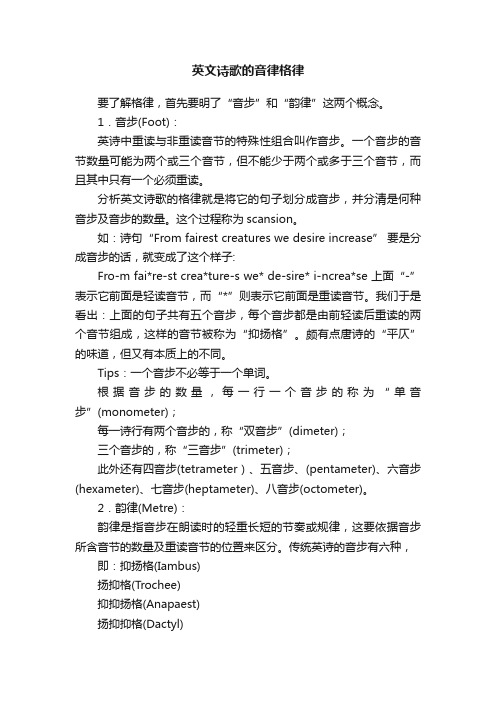
英文诗歌的音律格律要了解格律,首先要明了“音步”和“韵律”这两个概念。
1.音步(Foot):英诗中重读与非重读音节的特殊性组合叫作音步。
一个音步的音节数量可能为两个或三个音节,但不能少于两个或多于三个音节,而且其中只有一个必须重读。
分析英文诗歌的格律就是将它的句子划分成音步,并分清是何种音步及音步的数量。
这个过程称为scansion。
如:诗句“From fairest creatures we desire increase” 要是分成音步的话,就变成了这个样子:Fro-m fai*re-st crea*ture-s we* de-sire* i-ncrea*se 上面“-”表示它前面是轻读音节,而“*”则表示它前面是重读音节。
我们于是看出:上面的句子共有五个音步,每个音步都是由前轻读后重读的两个音节组成,这样的音节被称为“抑扬格”。
颇有点唐诗的“平仄”的味道,但又有本质上的不同。
Tips:一个音步不必等于一个单词。
根据音步的数量,每一行一个音步的称为“单音步”(monometer);每一诗行有两个音步的,称“双音步”(dimeter);三个音步的,称“三音步”(trimeter);此外还有四音步(tetrameter)、五音步、(pentameter)、六音步(hexameter)、七音步(heptameter)、八音步(octometer)。
2.韵律(Metre):韵律是指音步在朗读时的轻重长短的节奏或规律,这要依据音步所含音节的数量及重读音节的位置来区分。
传统英诗的音步有六种,即:抑扬格(Iambus)扬抑格(Trochee)抑抑扬格(Anapaest)扬抑抑格(Dactyl)抑扬抑格(Amphibrach)扬抑扬格(Dactyl)“抑”为轻读音节,“扬”为重读音节。
“扬抑格”即一个音步有两个音节,前面的音节重读,后面的轻读。
同理,“扬抑扬格”即一个音步有三个音节,最前的音节重读,中轻读,后重读。
五音步抑扬格
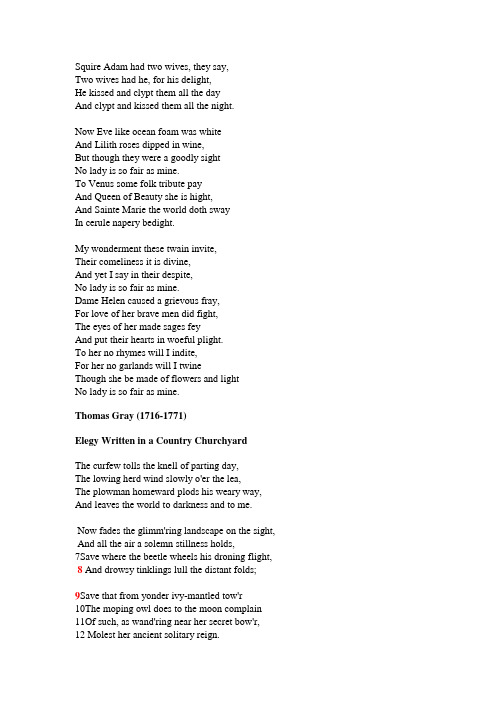
Squire Adam had two wives, they say,Two wives had he, for his delight,He kissed and clypt them all the dayAnd clypt and kissed them all the night.Now Eve like ocean foam was whiteAnd Lilith roses dipped in wine,But though they were a goodly sightNo lady is so fair as mine.To Venus some folk tribute payAnd Queen of Beauty she is hight,And Sainte Marie the world doth swayIn cerule napery bedight.My wonderment these twain invite,Their comeliness it is divine,And yet I say in their despite,No lady is so fair as mine.Dame Helen caused a grievous fray,For love of her brave men did fight,The eyes of her made sages feyAnd put their hearts in woeful plight.To her no rhymes will I indite,For her no garlands will I twineThough she be made of flowers and lightNo lady is so fair as mine.Thomas Gray (1716-1771)Elegy Written in a Country ChurchyardThe curfew tolls the knell of parting day,The lowing herd wind slowly o'er the lea,The plowman homeward plods his weary way, And leaves the world to darkness and to me.Now fades the glimm'ring landscape on the sight, And all the air a solemn stillness holds,7Save where the beetle wheels his droning flight, 8 And drowsy tinklings lull the distant folds;9Save that from yonder ivy-mantled tow'r10The moping owl does to the moon complain 11Of such, as wand'ring near her secret bow'r,12 Molest her ancient solitary reign.13Beneath those rugged elms, that yew-tree's shade, 14 Where heaves the turf in many a mould'ring heap, 15Each in his narrow cell for ever laid,16 The rude forefathers of the hamlet sleep.17The breezy call of incense-breathing Morn,18The swallow twitt'ring from the straw-built shed, 19The cock's shrill clarion, or the echoing horn,20No more shall rouse them from their lowly bed. 21For them no more the blazing hearth shall burn, 22 Or busy housewife ply her evening care:23No children run to lisp their sire's return,24Or climb his knees the envied kiss to share.25Oft did the harvest to their sickle yield,26 Their furrow oft the stubborn glebe has broke; 27How jocund did they drive their team afield!28How bow'd the woods beneath their sturdy stroke! 29Let not Ambition mock their useful toil,30Their homely joys, and destiny obscure;31Nor Grandeur hear with a disdainful smile32The short and simple annals of the poor.33The boast of heraldry, the pomp of pow'r,34And all that beauty, all that wealth e'er gave,35Awaits alike th' inevitable hour.36 The paths of glory lead but to the grave.37Nor you, ye proud, impute to these the fault,38If Mem'ry o'er their tomb no trophies raise,39Where thro' the long-drawn aisle and fretted vault 40The pealing anthem swells the note of praise.41Can storied urn or animated bust42Back to its mansion call the fleeting breath?43Can Honour's voice provoke the silent dust,44 Or Flatt'ry soothe the dull cold ear of Death?45Perhaps in this neglected spot is laid46Some heart once pregnant with celestial fire;47Hands, that the rod of empire might have sway'd,48 Or wak'd to ecstasy the living lyre.49But Knowledge to their eyes her ample page50Rich with the spoils of time did ne'er unroll;51Chill Penury repress'd their noble rage,52And froze the genial current of the soul.53Full many a gem of purest ray serene,54 The dark unfathom'd caves of ocean bear:55Full many a flow'r is born to blush unseen,56And waste its sweetness on the desert air.57Some village-Hampden, that with dauntless breast58 The little tyrant of his fields withstood;59Some mute inglorious Milton here may rest,60 Some Cromwell guiltless of his country's blood.61Th' applause of list'ning senates to command,62 The threats of pain and ruin to despise,63To scatter plenty o'er a smiling land,64 And read their hist'ry in a nation's eyes,1] First published, anonymously, 1751, under the title "An Elegy wrote in a Country Churchyard." The date of composition of the Elegy, apart from the concluding stanzas, cannot be exactly determined. The sole authority for the frequently repeated statement that Gray began the poem in 1742 is Mason's conjecture in the memoir prefixed to his edition of The Poems of Mr. Gray, 1775. The Elegy was concluded at Stoke Poges in June, 1750. (See letter to Walpole, June 12, 1750.) The churchyard as described by Gray is typical rather than particular; of the five disputed "originals" Stoke Poges bears the least resemblance to the graveyard in the Elegy. Five candidate churchyards for Gray's setting include Stoke Poges (unlikely), Upton (near Slough), Grantchester and Madingley (near Cambridge), and Thanington (near Canterbury), but the features might as readily be non-specific.curfew: originally rung at eight o'clock as a signal for extinguishing fires; after this practice had ceased, the word was applied to an evening bell. In his note to this first line Gray refers to Dante, Purgatorio, VIII, 5-6: "Squilla di lontano / Che paia 'l giorno pianger, che si muore."8] tinklings: made by sheep-bells.9] Cf. Robert Colvill's "Britain, a Poem," II, 45-57:Even thus, the keen ey'd falcon swift descendsOn Pallas' bird victorious; long he watch'dThe tempting spoil, and she his rage defy'd,Close shelter'd in her ivy mantl'd tower;Compell'd abroad, while circling slow she wheelsIn quest of food, and least expects the snare,Strait from his airy flight the victor stoops,As lightning-swift, and bears the captive prey. (450-57)16] rude: unlearned.17] incense-breathing: cf. Paradise Lost, IX, 193-4. Also Pope, Messiah, 24: "With all the incense of the breathing spring."19] The cock's shrill clarion: cf. Paradise Lost, VII, 443-44: "the crested cock, whose clarion sounds/The silent hours." Cf. Paul Whitehead's "The State of Rome" (1739), lines 173-74:But hold, War's Rumour! mark the loud Alarms!Hark the shrill Clarion sounds to Arms, to Arms!26] broke: old `strong' form of the past participle, `broken.'30] homely: domestic. 32] short and simple annals: parish registers of births, christenings, marriages, and deaths (Richard Leighton Greene, "Gray's Elegy written in a Country Churchyard," The Explicator 24.6 [Feb. 1966].)35] Cf. Henry Needler's "Horace. Book IV. Ode VII. Paraphras'd," lines 30-34: When once th' inevitable Hour is come,At which thou must receive thy final Doom;Thy Noble Birth, thy Eloquence Divine,And shining Piety shall nought enclineThe stubborn Will of unrelenting Fate ...and Richard West's "A Monody on the Death of Queen Caroline" (Dodsley's Collection of Poems [1748]: II, 273):Ah me! What boots us all our boasted power,Our golden treasure, and our purpled state?They cannot ward the inevitable hour,Nor stay the fearful violence of Fate.A collective (singular) subject is possible, though the word `hour' might also be the subject of the word `awaits.'36] Cf. Pope's "The First Book of the Odyssey," lines 391-92:O greatly bless'd with ev'ry blooming grace!With equal steps the paths of glory trace ..38] Trophies: memorials.39] fretted: adorned with carved or embossed work. Cf. Hamlet, II, ii: "this majestical roof fretted with golden fire."41] Cf. Samuel Whyte's "Elegy II" (1722), lines 119-20:No breathing Marble o'er his Dust shall stand;No storied Urn shall celebrate his Name ...43] provoke: in its original sense, to call forth, to challenge.51] rage: as often in the poetry of the eighteenth century, poetic fire (furor poeticus). 57] Hampden: John Hampden (ca. 1595-1643), one of the noblest of English Parliamentary statesmen; a central figure of the English revolution in its earlier stages. 59] Cf. Joseph Trapp's "Virgil's Aeneis," IV, 512-14:He, to protract his aged Father's Life,Chose Skill in Med'cine, and the Pow'rs of Herbs;And exercis'd a mute inglorious Art.69] conscious truth: truthful awareness of inward guilt.72] In the Eton MS. this line was followed by four stanzas which were omitted in the published text. Here, according to Mason, the poem was intended to close; the "hoary-headed swain" and the epitaph were after-thoughts.pious: dutiful.73] Cf. Henry Jones' "On seeing a Picture of his Royal Highness the Prince of Wales, which was presented to the University of Dublin" (1749), lines 61-64:Her favour'd Sons from 'midst the madding Crowd,Her Sons select with gentle Hand she drew,Secreted timely from th'austere and proud,Their Fame wide-spreading, tho' their Numbers few.madding: outraged.92] Gray's note refers to Petrarch's sonnet 169:Ch 'i veggio nel pensier, dolce mio fuoco,Fredda una lingua, et due begli occhi chiusiRimaner doppo noi pien di faville.。
英文诗歌的音律格律解析

英文诗歌的音律格律解析要了解格律,首先要明了“音步”和“韵律”这两个概念。
1.音步(Foot):英诗中重读与非重读音节的特殊性组合叫作音步。
一个音步的音节数量可能为两个或三个音节,但不能少于两个或多于三个音节,而且其中只有一个必须重读。
分析英文诗歌的格律就是将它的句子划分成音步,并分清是何种音步及音步的数量。
这个过程称为scansion。
如:诗句“From fairest creatures we desire increase” 要是分成音步的话,就变成了这个样子:Fro-m fai*re-st crea*ture-s we* de-sire* i-ncrea*se 上面“-”表示它前面是轻读音节,而“*”则表示它前面是重读音节。
我们于是看出:上面的句子共有五个音步,每个音步都是由前轻读后重读的两个音节组成,这样的音节被称为“抑扬格”。
颇有点唐诗的“平仄”的味道,但又有本质上的不同。
Tips:一个音步不必等于一个单词。
根据音步的数量,每一行一个音步的称为“单音步”(monometer);每一诗行有两个音步的,称“双音步”(dimeter);三个音步的,称“三音步”(trimeter);此外还有四音步(tetrameter)、五音步、(pentameter)、六音步(hexameter)、七音步(heptameter)、八音步(octometer)。
2.韵律(Metre):韵律是指音步在朗读时的轻重长短的节奏或规律,这要依据音步所含音节的数量及重读音节的位置来区分。
传统英诗的音步有六种,即:抑扬格(Iambus)扬抑格(Trochee)抑抑扬格(Anapaest)扬抑抑格(Dactyl)抑扬抑格(Amphibrach)扬抑扬格(Dactyl)“抑”为轻读音节,“扬”为重读音节。
“扬抑格”即一个音步有两个音节,前面的音节重读,后面的轻读。
同理,“扬抑扬格”即一个音步有三个音节,最前的音节重读,中轻读,后重读。
英语诗歌的写法和格式
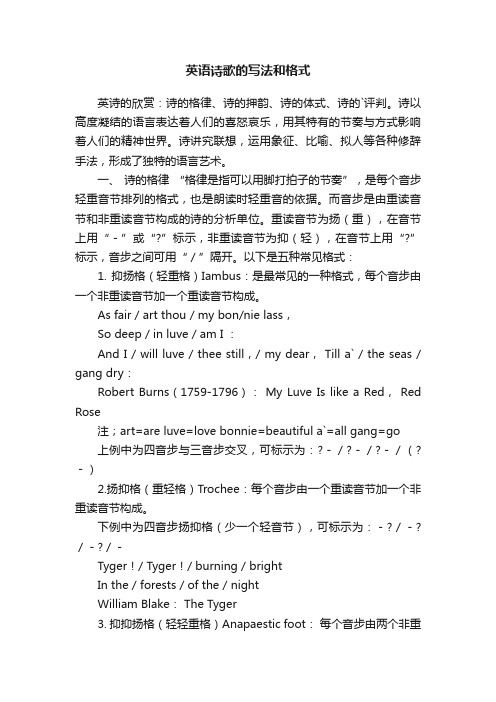
英语诗歌的写法和格式英诗的欣赏:诗的格律、诗的押韵、诗的体式、诗的`评判。
诗以高度凝结的语言表达着人们的喜怒哀乐,用其特有的节奏与方式影响着人们的精神世界。
诗讲究联想,运用象征、比喻、拟人等各种修辞手法,形成了独特的语言艺术。
一、诗的格律“格律是指可以用脚打拍子的节奏”,是每个音步轻重音节排列的格式,也是朗读时轻重音的依据。
而音步是由重读音节和非重读音节构成的诗的分析单位。
重读音节为扬(重),在音节上用“-”或“?”标示,非重读音节为抑(轻),在音节上用“?”标示,音步之间可用“/”隔开。
以下是五种常见格式:1. 抑扬格(轻重格)Iambus:是最常见的一种格式,每个音步由一个非重读音节加一个重读音节构成。
As fair / art thou / my bon/nie lass,So deep / in luve / am I :And I / will luve / thee still,/ my dear, Till a` / the seas / gang dry:Robert Burns(1759-1796):My Luve Is like a Red, Red Rose注;art=are luve=love bonnie=beautiful a`=all gang=go上例中为四音步与三音步交叉,可标示为:?-/?-/?-/(?-)2.扬抑格(重轻格)Trochee:每个音步由一个重读音节加一个非重读音节构成。
下例中为四音步扬抑格(少一个轻音节),可标示为:-?/-?/-?/-Tyger!/ Tyger!/ burning / brightIn the / forests / of the / nightWilliam Blake: The Tyger3. 抑抑扬格(轻轻重格)Anapaestic foot:每个音步由两个非重读音节加一个重读音节构成。
如:三音步抑抑扬格??-/??-/??-Like a child / from the womb,Like a ghost / from the tomb,I arise / and unbuild / it again.4. 扬抑抑格(重轻轻格)Dactylic foot:每个音步由一个重读音节加两个非重读音节构成。
如何鉴赏英语诗歌

如何鉴赏英语诗歌英语的诗歌怎么鉴赏?我为各位带来了下面几篇英语诗歌,希望对大家有帮助。
如何鉴赏英语诗歌一、诗的格律“格律是指可以用脚打拍子的节奏”,是每个音步轻重音节排列的格式,也是朗读时轻重音的依据.而音步是由重读音节和非重读音节构成的诗的'分析单位.重读音节为扬(重),在音节上用“-”或“?”标示,非重读音节为抑(轻),在音节上用“?”标示,音步之间可用“/”隔开.以下是五种常见格式:1. 抑扬格(轻重格)Iambus:是最常见的一种格式,每个音步由一个非重读音节加一个重读音节构成.As fair / art thou / my bon/nie lass,So deep / in luve / am I :And I / will luve / thee still,/ my dear, Till a` / the seas / gang dry:Robert Burns(1759-1796):My Luve Is like a Red, Red Rose注;art=are luve=love bonnie=beautiful a`=all gang=go上例中为四音步与三音步交叉,可标示为:2.扬抑格(重轻格)Trochee:每个音步由一个重读音节加一个非重读音节构成.下例中为四音步扬抑格(少一个轻音节),可标示为:Tyger!/ Tyger!/ burning / brightIn the / forests / of the / nightWilliam Blake: The Tyger3. 抑抑扬格(轻轻重格)Anapaestic foot:每个音步由两个非重读音节加一个重读音节构成.如:三音步抑抑扬格?-/?-/?-Like a child / from the womb,Like a ghost / from the tomb,I arise / and unbuild / it again.4. 扬抑抑格(重轻轻格)Dactylic foot:每个音步由一个重读音节加两个非重读音节构成.如:两音步扬抑抑格-?/-?Touch her not / ?scornfully,Think of her / ?mournfully.- Thomas Hood5. 抑扬抑格(轻重轻格)Amphibrach:每个音步由一个非重读音节加一个重读音节再加一个非重读音节构成.如:三音步抑扬抑格?-?/?-?/?-?下例中最后一个音步为抑扬格.O ?hush thee / my ?babie / thy ?sire was / a knight.在同一首诗中常会出现不同的格律,格律解析对朗读诗歌有一定参考价值.现代诗中常不遵守规范的格律.二、诗的押韵押韵是指通过重复元音或辅音以达到一定音韵效果的诗歌写作手法.1. 尾韵:最常见,最重要的押韵方式.1)联韵:aabb型.I shot an arrow into the air,It fell to earth, I knew not where;For, so swiftly it flew, the sightCould not follow it in its flight.Henry Wadsworth Longfellow: The Arrow and the Song2)交叉韵:abab型.Sunset and evening star,And one clear call for me!And may there be no moaning of the bar,When I put out to sea,Alfred Tennyson(1809-1892): Crossing the Bar3)同韵:有的诗押韵,一韵到底,大多是在同一节诗中共用一个韵脚.如下例就共用/i:p/为韵脚.The woods are lovely, dark and deep,But I have promises to keep,And miles to go before I sleep,And miles to go before I sleep.Robert Frost (1874-19633):Stopping by Woods on a Snowy Evening2. 头韵:是指一行(节)诗中几个词开头的辅音相同,形成押韵.下例中运用/f/、/b/与/s/头韵生动写出了船在海上轻快航行的景象.The fair breeze blew, the white foam flew,The furrow followed free,We were the first that ever burstInto that silent sea.。
英文诗歌韵律分析
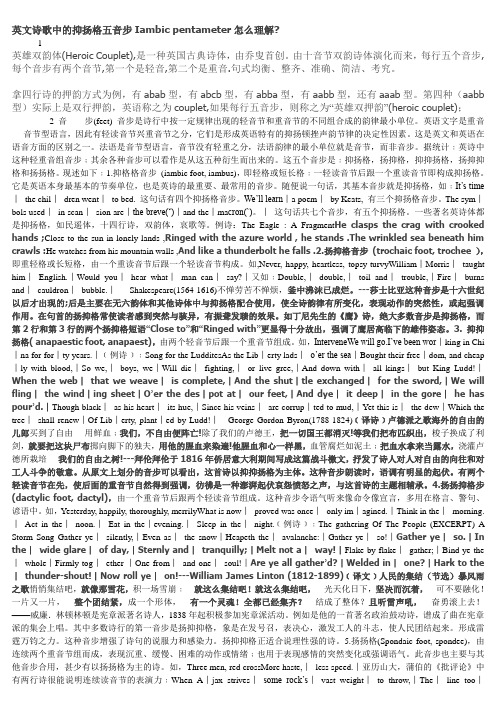
英文诗歌中的抑扬格五音步Iambic pentameter怎么理解?---------1英雄双韵体(Heroic Couplet),是一种英国古典诗体,由乔叟首创。
由十音节双韵诗体演化而来,每行五个音步,每个音步有两个音节,第一个是轻音,第二个是重音.句式均衡、整齐、准确、简洁、考究。
拿四行诗的押韵方式为例,有abab型,有abcb型,有abba型,有aabb型,还有aaab型。
第四种(aabb 型)实际上是双行押韵,英语称之为couplet,如果每行五音步,则称之为“英雄双押韵”(heroic couplet);-------------2音步(feet) 音步是诗行中按一定规律出现的轻音节和重音节的不同组合成的韵律最小单位。
英语文字是重音----音节型语言,因此有轻读音节兴重音节之分,它们是形成英语特有的抑扬顿挫声韵节律的决定性因素。
这是英文和英语在语音方面的区别之一。
法语是音节型语言,音节没有轻重之分,法语韵律的最小单位就是音节,而非音步。
据统计﹕英诗中这种轻重音组音步﹔其余各种音步可以看作是从这五种衍生而出来的。
这五个音步是﹕抑扬格,扬抑格,抑抑扬格,扬抑抑格和扬扬格。
现述如下﹕1.抑格格音步(iambic foot, iambus),即轻格或短长格﹕一轻读音节后跟一个重读音节即构成抑扬格。
它是英语本身最基本的节奏单位,也是英诗的最重要、最常用的音步。
随便说一句话,其基本音步就是抑扬格,如﹕It’s time ︱the chil︱dren went︱to bed. 这句话有四个抑扬格音步。
We’ll learn︱a poem︱by Keats, 有三个抑扬格音步。
The sym︱bols used︱in scan︱sion are︱the breve(ˇ)︱and the︱macron(ˋ)。
︱这句话共七个音步,有五个抑扬格。
一些著名英诗体都是抑扬格,如民遥体,十四行诗,双韵体,哀歌等。
【英国文学期末复习资料】之英国文学诗歌的鉴赏方法及基本概念
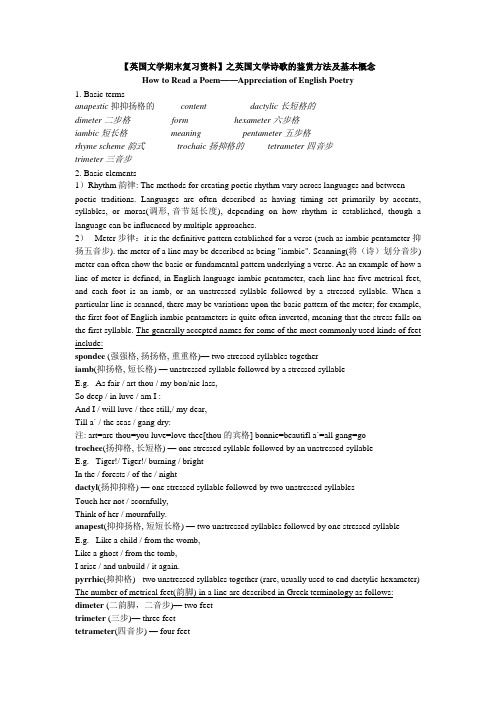
【英国文学期末复习资料】之英国文学诗歌的鉴赏方法及基本概念How to Read a Poem——Appreciation of English Poetry1. Basic termsanapestic抑抑扬格的 content dactylic长短格的dimeter二步格 form hexameter六步格iambic短长格 meaning pentameter五步格rhyme scheme韵式 trochaic扬抑格的 tetrameter四音步trimeter三音步2. Basic elements1)Rhythm韵律: The methods for creating poetic rhythm vary across languages and between poetic traditions. Languages are often described as having timing set primarily by accents, syllables, or moras(调形, 音节延长度), depending on how rhythm is established, though a language can be influenced by multiple approaches.2)Meter步律:it is the definitive pattern established for a verse (such as iambic pentameter抑扬五音步). the meter of a line may be described as being "iambic". Scanning(将(诗)划分音步) meter can often show the basic or fundamental pattern underlying a verse. As an example of how a line of meter is defined, in English-language iambic pentameter, each line has five metrical feet, and each foot is an iamb, or an unstressed syllable followed by a stressed syllable. When a particular line is scanned, there may be variations upon the basic pattern of the meter; for example, the first foot of English iambic pentameters is quite often inverted, meaning that the stress falls on the first syllable. The generally accepted names for some of the most commonly used kinds of feet include:spondee (强强格, 扬扬格, 重重格)— two stressed syllables togetheriamb(抑扬格, 短长格) — unstressed syllable followed by a stressed syllableE.g. As fair / art thou / my bon/nie lass,So deep / in luve / am I :And I / will luve / thee still,/ my dear,Till a` / the seas / gang dry:注: art=are thou=you luve=love thee[thou的宾格] bonnie=beautifl a`=all gang=gotrochee(扬抑格, 长短格) — one stressed syllable followed by an unstressed syllableE.g. Tiger!/ Tiger!/ burning / brightIn the / forests / of the / nightdactyl(扬抑抑格) — one stressed syllable followed by two unstressed syllablesTouch her not / scornfully,Think of her / mournfully.anapest(抑抑扬格, 短短长格) — two unstressed syllables followed by one stressed syllableE.g. Like a child / from the womb,Like a ghost / from the tomb,I arise / and unbuild / it again.pyrrhic(抑抑格) - two unstressed syllables together (rare, usually used to end dactylic hexameter) The number of metrical feet(韵脚) in a line are described in Greek terminology as follows: dimeter (二韵脚,二音步)— two feettrimeter (三步)— three feettetrameter(四音步) — four feetpentameter(五音步) — five feethexameter(六步格,)— six feetheptameter(七步格) — seven feetoctameter(八步格)— eight feetEach of these types of feet has a certain "feel," whether alone or in combination with other feet. The iamb, for example, is the most natural form of rhythm in the English language, and generally produces a subtle but stable verse. The dactyl, on the other hand, almost gallops along. And, as readers of The Night Before Christmas or Dr. Seuss realize, the anapest(抑抑扬格, 短短长格) is perfect for a light-hearted, comic feel.Note: Rhythm and meter, although closely related, should be distinguished. Meter is the definitive pattern established for a verse (such as iambic pentameter抑扬五音步), while rhythm is the actual sound that results from a line of poetry. Thus, the meter of a line may be described as being "iambic", but a full description of the rhythm would require noting where the language causes one to pause or accelerate and how the meter interacts with other elements of the language.3)Metrical patternsDifferent traditions and genres of poetry tend to use different meters, ranging from the Shakespearian iambic pentameter and the Homerian dactylic hexameter to the Anapestic tetrameter used in many nursery rhymes. However, a number of variations to the established meter are common, both to provide emphasis or attention to a given foot or line and to avoid boring repetition. For example, the stress in a foot may be inverted, a caesura(节律的停顿)(or pause) may be added (sometimes in place of a foot or stress), or the final foot in a line may be given a feminine(阴性的) ending to soften it or be replaced by a spondee(强强格) to emphasize it and create a hard stop. Some patterns (such as iambic pentameter) tend to be fairly regular, while other patterns, such as dactylic hexameter, tend to be highly irregular. Regularity can vary between language. In addition, different patterns often develop distinctively in different languages, so that, for example, iambic tetrameter in Russian will generally reflect a regularity in the use of accents to reinforce the meter, which does not occur or occurs to a much lesser extent in English.Some common metrical patterns, with notable examples of poets and poems who use them, include:Iambic pentameter抑扬格五音步 (John Milton, Paradise Lost)Dactylic hexameter (Homer, Iliad; Ovid, The Metamorphoses)Iambic tetrameter (Andrew Marvell, "To His Coy Mistress")Iambic tetrameter (Aleksandr Pushkin, Eugene Onegin)Trochaic octameter (Edgar Allan Poe, "The Raven")Anapestic tetrameter (Lewis Carroll, "The Hunting of the Snark"; Lord Byron, Don Juan) Alexandrine, also known as iambic hexameter (Jean Racine, Phèdre)For example:An EMPTY HOUSE - Alexander PopeYou beat│your pate, │and fan│cy wit │will come:Knock as│you please, │there’s no│body│at home.(你拍拍脑袋,以为灵感马上就来。
英文诗歌节奏划分
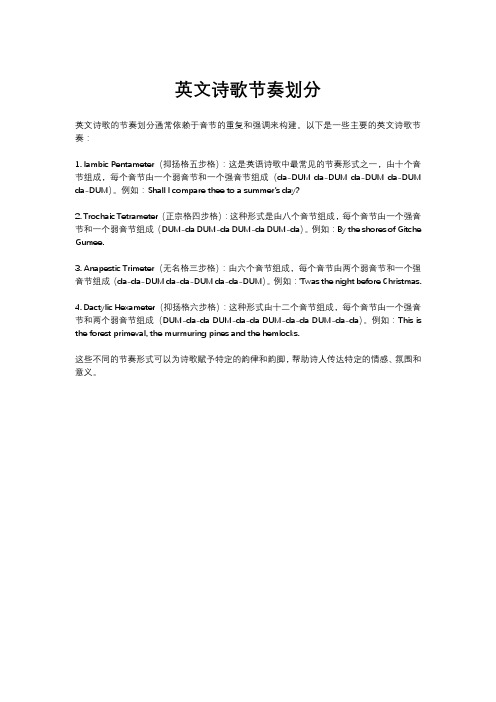
英文诗歌节奏划分
英文诗歌的节奏划分通常依赖于音节的重复和强调来构建。
以下是一些主要的英文诗歌节奏:
1. Iambic Pentameter(抑扬格五步格):这是英语诗歌中最常见的节奏形式之一,由十个音节组成,每个音节由一个弱音节和一个强音节组成(da-DUM da-DUM da-DUM da-DUM da-DUM)。
例如:Shall I compare thee to a summer's day?
2. Trochaic Tetrameter(正宗格四步格):这种形式是由八个音节组成,每个音节由一个强音节和一个弱音节组成(DUM-da DUM-da DUM-da DUM-da)。
例如:By the shores of Gitche Gumee.
3. Anapestic Trimeter(无名格三步格):由六个音节组成,每个音节由两个弱音节和一个强音节组成(da-da-DUM da-da-DUM da-da-DUM)。
例如:'Twas the night before Christmas.
4. Dactylic Hexameter(抑扬格六步格):这种形式由十二个音节组成,每个音节由一个强音节和两个弱音节组成(DUM-da-da DUM-da-da DUM-da-da DUM-da-da)。
例如:This is the forest primeval, the murmuring pines and the hemlocks.
这些不同的节奏形式可以为诗歌赋予特定的韵律和韵脚,帮助诗人传达特定的情感、氛围和意义。
- 1、下载文档前请自行甄别文档内容的完整性,平台不提供额外的编辑、内容补充、找答案等附加服务。
- 2、"仅部分预览"的文档,不可在线预览部分如存在完整性等问题,可反馈申请退款(可完整预览的文档不适用该条件!)。
- 3、如文档侵犯您的权益,请联系客服反馈,我们会尽快为您处理(人工客服工作时间:9:00-18:30)。
英文诗歌的五步抑扬格音步(feet)音步是诗行中按一定规律出现的轻音节和重音节的不同组合成的韵律最小单位。
英语文字是重音----音节型语言,因此有轻读音节兴重音节之分,它们是形成英语特有的抑扬顿挫声韵节律的决定性因素。
这是英文和英语在语音方面的区别之一。
法语是音节型语言,音节没有轻重之分,法语韵律的最小单位就是音节,而非音步。
据统计﹕英诗中这种轻重音组音步﹔其余各种音步可以看作是从这五种衍生而出来的。
这五个音步是﹕抑扬格,扬抑格,抑抑扬格,扬抑抑格和扬扬格。
现述如下﹕1.抑格格音步 (iambic foot, iambus) ,即轻格或短长格﹕一轻读音节后跟一个重读音节即构成抑扬格。
它是英语本身最基本的节奏单位,也是英诗的最重要、最常用的音步。
随便说一句话,其基本音步就是抑扬格,如﹕It’s time︱ the chil︱ dren went︱ to bed. 这句话有四个抑扬格音步。
We’ll learn︱a poem︱ by Keats, 有三个抑扬格音步。
The sym︱ bols used︱ in scan︱ sion are︱the breve(ˇ)︱and the︱macron(ˋ)。
︱这句话共七个音步,有五个抑扬格。
一些著名英诗体都是抑扬格,如民遥体,十四行诗,双韵体,哀歌等。
例诗:The Eagle : A FragmentHe clasps the crag with crooked hands ;Close to the sun in lonely lands ,Ringed with the azure world , he stands .The wrinkled sea beneath him crawls :He watches from his mountain walls ,And like a thunderbolt he falls .2.扬抑格音步 (trochaic foot, trochee ,即重轻格或长短格,由一个重读音节后跟一个轻读音节构成。
如,Never, happy, heartless, topsy-turvyWilliam︱Morris︱ taught him︱ English.︱Would you︱ hear what︱ man can︱ say?︱又如﹕Double,︱ double,︱ toil and︱ trouble,︱Fire︱ burns and︱ cauldron︱ bubble.︱--- Shakespeare(1564-1616)不惮劳苦不惮烦,釜中沸沫已成烂。
- --莎士比亚这种音步是十六世纪以后才出现的;后是主要在无六韵体和其他诗体中与抑扬格配合使用,使全诗韵律有所变化,表现动作的突然性,或起强调作用。
在句首的扬抑格常使读者感到突然与骇异,有振聋发聩的效果。
如丁尼先生的《鹰》诗,绝大多数音步是抑扬格,而第2行和第3行的两个扬抑格短语“Close to”和“Ringed with”更显得十分故出,强调了鹰居高临下的雄伟姿态。
3. 抑抑扬格( anapaestic foot, anapaest),由两个轻音节后跟一个重音节组成。
如,InterveneWe will go.I’ve been wor︱king in Chi︱na for for︱ty years.︱﹝例诗﹞﹕Song for the LudditesAs the Lib︱erty lads︱o’er the sea︱Bought their free︱dom, and cheap︱ly with blood,︱So we,︱ boys, we︱Will die︱ fighting,︱ or live gree,︱And down with︱ all kings︱ but King Ludd!︱When the web︱ that we weave︱ is complete,︱And the shut︱tle exchanged︱ for the sword,︱We will fling︱ the wind︱ing sheet︱O’er the des︱pot at︱ our feet,︱And dye︱ it deep︱ in the gore︱ he has pour’d.︱Though black︱ as his heart︱ its hue,︱Since his veins︱ are corrup︱ted to mud,︱Yet this is︱ the dew︱Which the tree︱ shall renew︱Of Lib︱erty, plant︱ed by Ludd!︱---George Gordon Byron(1788-1824)﹝译诗﹞卢尔德派之歌海外的自由的儿郎买到了自由----用鲜血﹔我们,不自由便阵亡!除了我们的卢尔德王,把一切国王都消灭!等我们把布匹织出,梭子换成了利剑,就要把这块尸布掷向脚下的独夫,用他的腥血来染遍!他腥血和心一样黑,血管腐烂如泥土﹔把血水拿来当露水,浇灌卢尔德所栽培----我们的自由之树!---拜伦拜伦于1816年侨居意大利期间写成这篇战斗檄文,抒发了诗人对人对自由的向往和对工人斗争的敬意。
从原文上划分的音步可以看出,这首诗以抑抑扬格为主体。
这种音步朗读时,语调有明显的起伏。
有两个轻读音节在先,使后面的重音节自然得到强调,彷佛是一种澎湃起伏哀怨愤怒之声,与这首诗的主题相辅承。
4.扬扬抑格步 (dactylic foot, dactyl),由一个重音节后跟两个轻读音节组成。
这种音步令语气听来像命令像宣言,多用在格言、警句、谚语中。
如,Yesterday, happily, thoroughly, merrilyWhat is now︱ proved was once︱ only im︱agined.︱Think in the︱ morning.︱ Act in the︱ noon.︱ Eat in the︱evening.︱ Sleep in the︱ night.﹝例诗﹞﹕The gathering Of The People (EXCERPT)A Storm SongGather ye︱ silently,︱Even as︱ the snow︱Heapeth the︱ avalanche:︱Gather ye︱ so!︱Gather ye︱ so.︱In the︱ wide glare︱ of day,︱Sternly and︱ tranquilly;︱Melt not a︱ way!︱Flake by flake︱ gather;︱Bind ye the︱ whole︱Firmly tog︱ ether-︱One from︱ and one︱ soul!︱Are ye all gather’d?︱Welded in︱ one?︱Hark to the︱ thunder-shout!︱Now roll ye︱ on!---William James Linton (1812-1899)﹝译文﹞人民的集结(节选)暴风雨之歌悄悄集结吧,就像那雪花,积一场雪崩﹕就这么集结吧!就这么集结吧,光天化日下,坚决而沉着,可不要融化!一片又一片,整个团结紧,成一个形体,有一个灵魂!全都已经集齐?结成了整体?且听雷声吼,奋勇滚上去!───威廉.林顿林顿是宪章派著名诗人,1838年起积极参加宪章派活动。
例如是他的一首著名政治鼓动诗,谱成了曲在宪章派的集会上唱。
其中多数诗行的第一音步是扬抑抑格,像是在发号召,表决心,激发工人的斗志,使人民团结起来。
形成雷霆万钧之力。
这种音步增强了诗句的说服力和感染力。
扬抑抑格正适合说理性强的诗。
5.扬扬格(Spondaic foot, spondee),由连续两个重音节组而成,表现沉重、缓慢、困难的动作或情绪﹔也用于表现感情的突然变化或强调语气。
此音步也主要与其他音步合用,甚少有以扬扬格为主的诗。
如,Three men, red crossMore haste,︱ less speed.︱亚历山大,蒲伯的《批评论》中有两行诗很能说明连续读音节的表演力﹕When A︱jax strives︱ some rock’s︱ vast weight︱ to throw,︱The︱ line too︱ labours,︱ the words︱ move slow.︱当埃阿斯奋力举起千钧巨石砸去,诗行也变得沉重,充满缓慢的字句。
蒲伯的《批评论》是新古典主义的韵体文论著作。
Ajax是指希腊神话中的埃阿斯(Ajax the Great)。
他骁勇善战,身材魁梧,力大无比,是特洛伊战中的英雄。
不同的内容要用不同的韵律也要变得费力、迟缓。
第一行中的扬扬格“vast weight”表现巨石的沉重。
第二行的扬扬格的着例。
共八个字,九个音节。
有六个皇音读音节,都是实词,更能表现句中格调的巍峨。
这一行共有两个扬扬格音步。
这样的诗句只能用加重的语气缓慢朗读,想快也快不起来,因只有轻读音节多时才能读得快。
同一首诗中接下来的两行就是读得快的例子,那是描写古罗马诗人弗吉尔的史诗《伊尼特》(Aeneid)中的女英雄---“飞毛腿”卡米拉(Camilla)。
为帮助记忆以上几个主要音步,现向读者推荐一首顺口溜﹕Iambics march from short long;Trochee trips from long to short.Slow spondee stalks, strong feet,Ever to come up with dactyl trisyllable.如何划分音步首先要初步读懂诗,至少要看懂诗的大意,并根据理解进行朗读或实际或默读,然后按实际读出的音划分出重音音节和轻读音节,切要时还有次重音节﹔晒最后找出占多数的音步,进行归纳划分。
一般来说,实词(包括名词、动词、副词等),要重读﹔虚词(包括名词、冠词、介词等),要轻读。
但实词轻读,虚词重读,虚词重读的情况也不少。
切忌按固定的框框去硬套﹔如,知道十四行诗多是抑扬格,于是见到十四行诗就按抑扬格划分音步,甚至照这样的划法来理解诗意和朗,这样就本末倒置了,因为在实际应用中会出现许多变化。
像莎士比亚在他的第116首十四行诗中,第一行就用了两处扬抑格,两处扬抑抑格,以表示对旧制度抗争和对世人的勤戒﹕Let me︱ not to the︱ marriage of︱ true minds︱Admit︱ impediments.︱如果只是接固定的模式去硬套不同的诗,划分音步的义就不大了。
划分音步的目的之一是要看到诗人在一个总的韵律之内有那些变化。
